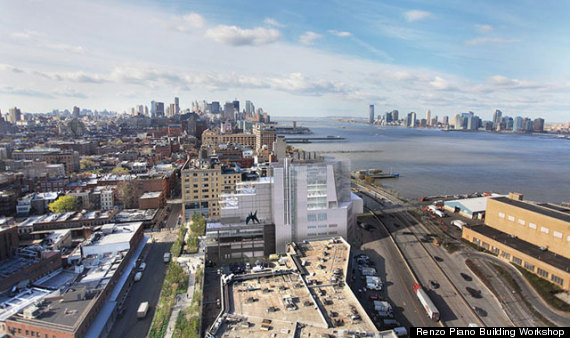Whitney Museum director Adam Weinberg opened the June 26 preview of the museum's new Renzo Piano-designed building in the Meatpacking District with an anecdote: about a group of artists who had toured the site, currently halfway through construction, two months ago. Mark di Suvero was thrilled with the space in its unfinished condition, insisting that his art would look fantastic in a museum without walls. Frank Stella, however, was unenthused by Suvero's suggestion, and told Christo that he should wrap the building -- "It would help us who do paintings." Weinberg emphasized, after the assembled press issued a collective giggle, that "the first groups of people brought up here were the artists."

A rendering of the new Whitney building /Image courtesy of Renzo Piano Building Workshop in collaboration with Cooper, Robertson & Partners
"This is a space that is about art, it's not about architecture per se," Weinberg further explained of the Whitney's new site, which is slated to open to the public in 2015. The museum wants a building, says the director, "that does not dominate art, but houses art, that is respectful to art and is deferential to art." Renzo Piano, who has established a grand reputation on building elegant but innocuous -- and ultimately bland -- museums and additions, is the Whitney's ideal architect. Weinberg's remarks validated Justin Davidson's observation upon the downtown location's 2011 groundbreaking that this building "is a missed opportunity of majestic proportions...[Piano] has capped the High Line with a pale, metal-clad tower, interlocked with a stack of horizontal blocks that step back in the manner of a clunky cruise ship." Piano is giving the museum a building that is not bad so much as it is aesthetically unremarkable, because this is precisely what the Whitney wants.
Drawings curator Carter Foster succinctly summed up the future Whitney's architecture: it's a building that is "better from the inside than the outside." The interior is packed with state-of-the-art screening and research facilities, from a high-tech film and video gallery overlooking the Hudson to an expansive works-on-paper study center that will allow the museum to hold two-thirds of its collection in that department on site. In fact, Piano's Whitney will provide 18,000 more square feet of gallery space than the museum's current Marcel Breuer home uptown to display more of the permanent collection. However, the indifference toward architecture does extend to the interior design of the museum: a 260-foot-long gallery space is lauded for its expansive openness, but the absence of columns and any other interior architecture to organize the space highlights that Weinberg, his board, and his curators believe that design elements detract from the museological undertaking.

A rendering of the new Whitney building /Courtesy Renzo Piano Building Workshop in collaboration with Cooper, Robertson & Partners
Piano's building is designed to be looked out of, not looked at. Floor-to-ceiling glass windows will establish porousness between the museum and the city, allowing Whitney visitors to enjoy sweeping views of the surrounding neighborhood and the Hudson River, while asserting the symbolic significance of the westward view toward the rest of America. But using glass to create a platform for appreciating surrounding architecture is not enough to integrate the building into the impressive architectural ensemble that already exists in the Meatpacking District. The future museum building's poured concrete, steel, and glass façade will appear drab and feature-less alongside Ennead's Standard Hotel, which integrates the High Line into its design -- Piano's Whitney merely sits next to it.
Weinberg's comments established a hierarchy between the future Whitney building, the art it will house, and the neighborhood that it will inhabit. By prioritizing its architecture below its art, the Whitney shows that it wants to profit from the creative energy generated by the neighborhood's urban renewal projects, without thoroughly considering how its own presence will mesh with the neighborhood's many repurposed and re-used industrial spaces that embrace MePa's history. In choosing to raze the defunct warehouses that previously stood on the site of the museum's new building -- instead of adaptively re-using them as part of the Piano building's design -- the Whitney bypassed the opportunity to engage with the pre-existing urban fabric and historic identity of its new neighborhood. The Whitney will certainly attract many visitors as the sole large-scale art institution in a sea of galleries, but its architectural presence will help make it "MoMA South," as Davidson put it, "a thoroughly corporate museum -- airy, spacious, efficient, and utterly sterile."

Courtesy Renzo Piano Building Workshop in collaboration with Cooper, Robertson & Partners
The Whitney preview was bookended by the opening of "Fragments" at Gagosian Gallery, an overview of the Renzo Piano Building Workshop's architectural output in its 32-year history. The title is appropriate, as the show feels fragmented: 24 tables display assorted architectural objects, related reading materials are strewn next to building models, and photographs hang from the ceiling confuse rather than guide the visitor. There is little curatorial perspective to the show's organization -- it's unclear what theme unites the projects on display beyond their mutual progenitor -- save for the emphasis on Piano's many museum projects. It is one thing when a major retrospective of an architect follows his or her reception of a major prize or award, such as, in Piano's case, the 1998 Pritzker; but this uninspired exhibition, as it opens in concert with the Whitney's hardhat preview, seems to serve simply to generate press for the museum, its new building, and its impending entrance into the Meatpacking District's cultural milieu. Ultimately, the correspondence of the press preview and the exhibition illustrates that the new Whitney building and the Gagosian show suffer from the same diagnosis as much of Piano's recent architecture: they are boring.
-Anna Kats, BLOUIN ARTINFO
More of Today's News from BLOUIN ARTINFO:
Like what you see? Sign up for BLOUIN ARTINFO's daily newsletter to get the latest on the market, emerging artists, auctions, galleries, museums, and more.